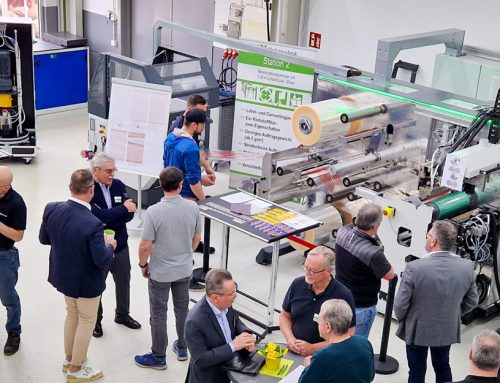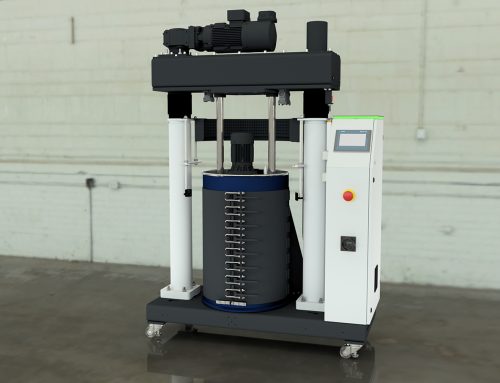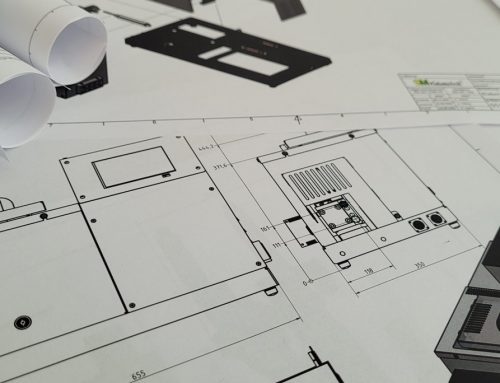Contactless hotmelt curtain coating of textile surfaces
The hotmelt coating of technical textiles or non-wovens is now established and state-of-the-art. Roll or wide-slot nozzle systems are mostly used for this, both application techniques working in contact with the substrates. Could contactless hotmelt application with a wide-slot nozzle die offer an advantage?
The application weights for the roller or wide-slot nozzle technology vary greatly depending on the application and can be between 3 g / m² and 60 g / m² – and in special cases significantly higher. Each method has advantages, but also disadvantages. For this reason, it makes sense to check whether and which options are available for optimisation.
Roller system
Hotmelt coating with a roller system is inexpensive, but also cleaning-intensive. As soon as PUR hotmelt or other reactive hotmelts are processed, daily cleaning of the roller surfaces is absolutely essential to ensure the system’s function. In this case, PUR cleaners are used which are generally more expensive than the adhesive itself. The disposal of the cleaner, enriched with adhesive, is a further consideration. Even during production with a roller system, soiling from textile abrasion or fibres can repeatedly occur which often leads to faults in the application pattern of the adhesive and, in turn, results in rejects.
Wide-slot nozzle system
In contrast to the roller system, the wide-slot nozzle, which is in contact with the substrate during application, does not require daily cleaning. Soiling on the nozzle lip is still present. An even, open application (i.e. air-permeable hotmelt application) with a wide-slot nozzle is only possible with a very good adhesive distribution within the nozzle. However, many inexpensive wide-slot nozzles that are available on the market have significant problems with this.
Contactless laminating
A contactless hotmelt application with a wide-slot nozzle (Fig. 1) could offer the following advantages over the conventional process (Fig. 2):
- no excessive hotmelt application,
- a very even adhesive distribution over the entire surface,
- low heat transfer from the wide-slot nozzle to the substrate,
- No contamination of the nozzle lip, so no cleaning.
To verify these assumptions, a textile and a foam product were first laminated with approx. 45 g / m² of PUR hotmelt. The objective was to achieve the lamination of the material composite with an adhesive quantity of less than 50% compared to the conventional technique.
The application technique used for this was:
- a KC nozzle with an application width of 500 mm and
- a 200 L drum melter for PUR hotmelt.
The structure of the system is shown in Figure 3. First, the textile was completely coated with a PUR hotmelt, which has a short open time and a very strong initial adhesive force, with the adhesive film being applied at 5 g / m² (Fig. 4). After coating, a closed film was immediately formed on the textile. To achieve an air-permeable bond, the adhesive film was then heated by an IR heater (Fig. 5). To check the uniformity of the adhesive application, the PUR hotmelt contained a UV brightener so that it could be seen clearly in black light (Figure 6). In doing so, it was possible to apply a hotmelt film without contact on a textile surface and then to make it air-permeable. In a further step, the textile was laminated to a PUR foam product with the re-liquified PUR hotmelt. Strength tests showed that there was a tear in the PUR foam. Thus, it was possible to successfully laminate with only 5 g / m². This successful outcome had not been expected by either the SM Klebetechnik team or the corresponding client at the start of the test.
Conclusion: a real alternative to conventional application techniques
The technique described above has been used for a large number of applications for years (table 1) and has long been state-of-the-art in film laminating or label production.
It has now been shown that the curtain coating hotmelt technique is also suitable for coating or laminating textile materials and can be viewed as a real alternative to conventional application techniques. However, the respective adhesive must be subjected to an application test beforehand in order to obtain information about its curtain coating properties. Many hotmelts already meet these requirements (table 2). The next few years will reveal whether this application technique will also establish itself in the field of textile surfaces. //




